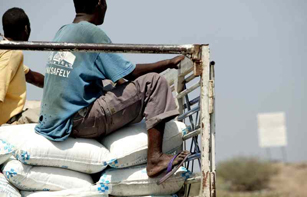
Credit: UNAIDS/P.Virot
Men, women and children on HIV treatment in drought-affected Ethiopia will benefit from a US$ 56 million donation from the US President’s Emergency Plan for AIDS Relief (PEPFAR) to the World Food Programme (WFP).
The donation will allow the UN agency to increase vital nutritional support to people on HIV treatment—who are often already weakened by malnutrition—and their families. Spread over five years, it is the largest contribution ever made from PEPFAR to WFP.
Welcoming the donation, Josette Sheeran, WFP Executive Director emphasized that the provision of the right nutritional support for people on HIV treatment “can make the difference between life and death. Because when malnourished people do not have the right food to eat, treatment does not work.” She added that WFP would now be able to reach more people; assisting families affected by AIDS with sustainable food security and helping to eliminate new HIV infections among children and keep their mothers alive.
Supporting children living with HIV by helping ensure good nutrition is a key concern which echoes the WFP’s new global initiative to mark World Food Day: ‘Feed a child, feed a dream’. Through an online platform, the initiative highlights the aspirations of some of the many children being supported by WFP around the world and how they can be met.
WFP will now expand its areas of operation into the country’s least developed regions of Afar, Benishangul Gumuz, Somali and Gambella to improve the nutritional status, treatment success and quality of life of people on HIV treatment and their families.
At present WFP supports HIV treatment in urban areas, including assessments, counselling and food assistance for those who are malnourished. From 2008 to 2010, an estimated 355 000 people living in households affected by AIDS in 23 towns benefited from these activities. With PEPFAR’s donation, WFP can reach an additional 375 000 people living in households affected by AIDS—those that are most vulnerable to malnutrition and food insecurity—over the next five years.
The entry criterion for the receipt of food aid is the nutritional status of the individuals as measured by body mass index for example. All people on antiretroviral therapy (ART) receive nutrition education and counselling, and only those who are malnourished will receive food rations for a period of six months. Experience has shown that nutritional recovery (>85% weight for height) occurs rapidly when ART is combined with food assistance.
Food and nutrition assistance is an essential and cost-effective means of enhancing the success of antiretroviral treatment (ART), enabling nutritional recovery and mitigating the socio-economic consequences of HIV and tuberculosis. Furthermore, this type of assistance increases the likelihood that patients will adhere to treatment, thereby reducing the likelihood that additional, more costly treatments will need to be found.
WFP is the largest humanitarian agency fighting hunger worldwide. It feeds more than 90 million people in over 70 countries every year. In 2010, WFP supported 2.5 million beneficiaries in nearly 50 countries through its HIV and Tuberculosis (TB) programmes. This included food and nutritional support to some 500,000 people living with HIV as part of their antiretroviral therapy or TB treatment.




